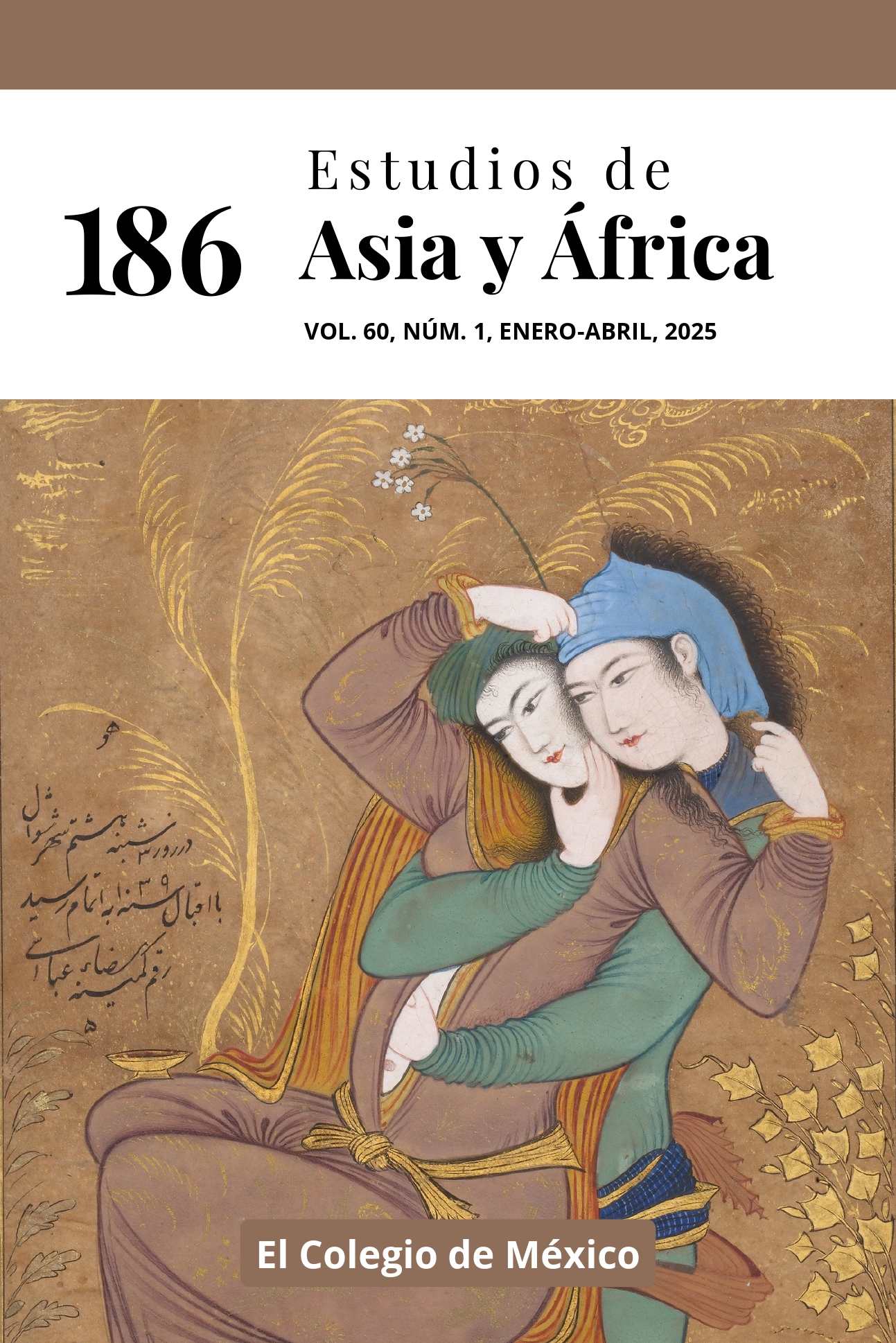Abstract
This article analyzes the synonyms and meanings of the vulva compiled in Medieval Arab and Islamic erotic literature, from the advent of Islam to the arrival of the Ottoman Empire. In the first section, the justification of the foundational texts of Islam in relation to eroticism and the female sex is briefly introduced, together with support for the theory of this Arab obsession when classifying and reifying the female body. On the other hand, the second part is dedicated to the terminological analysis of the lexicon collected by writers and chroniclers on fictionalized vulvas and to the role that each terminology plays in the sources described: synonymic, metonymic, explanatory, encyclopedic, descriptive, and derogatory.
References
Abū, Ḥukayma. 1997. Dīwān Abī Ḥukayma fī al-ayriyyāt. Editado por Muḥammad Ḥussayn al-‘Urŷī. Colonia: Al-Kamel Verlag.
Aít Sabbah, Fatna. 2000. La mujer en el inconsciente musulmán. Traducido por Inmaculada Jiménez Morell. Madrid: Ediciones del Oriente y del Mediterráneo.
Álvarez de Morales, Camilo. 1998. “El cuerpo humano en la medicina árabe medieval. Nociones generales sobre la anatomía”. En Ciencias de la naturaleza en al-Andalus: textos y estudios, vol. 5, editado por Expiración García Sánchez, 121-135. Granada: Consejo Superior de Investigaciones Científicas.
Basilio Santos, Amanda. 2015. “A representação e a interpretação: a Sheela-na-Gig entre o pecado e a devoção”. Medievalis 4 (1): 1-15. https://doi.org/10.55702/medievalis.v4i1.44259
Buendía, Pedro. 2015. “Ibn Sīdah y el sexo: en torno al vocabulario de índole sexual en el Kitāb al-Muḫaṣṣaṣ (s. xi)”. Arabica 62 (2-3): 328-360. https://doi.org/10.1163/15700585-12341354
Cadden, Joan. 1995. Meanings of Sex Cadden, Joan. 1995. Meanings of Sex Difference in the Middle Ages: Medicine, Science, and Culture. Cambridge: Cambridge University Press.
Castañeda Reyes, José Carlos. 2004. “De la mujer en la tradición religiosa y en algunos ejemplos literarios del mundo islámico”. Estudios de Asia y África 39 (3): 623-671. https://doi.org/10.24201/eaa.v39i3.1800
Corriente, Federico. 2008. Dictionary of Arabic and Allied Loanwords: Spanish, Portuguese, Catalan, Galician and Kindred Dialects. Leiden: Brill. https://doi.org/10.1163/ej.9789004168589.i-602
El Corán. 1973. Traducción, introducción y notas de Juan Vernet. Barcelona: Planeta.
Ghersetti, Antonella. 2007. “The Semiotic Paradigm: Physiognomy and Medicine in Islamic Culture”. En Seeing the Face, Seeing the Soul: Polemon’s Physiognomy from Classical Antiquity to Medieval Islam, editado por Simon Swain, 281-308. Oxford: Oxford University Press.
Ghersetti, Antonella. 2018. “The Representation of Slave Girls in a Physiognomic Text of the Fourteenth Century”. Mamlūk Studies Review 21: 21-45. https://doi.org/10.6082/ah14-2x46
Ibn al-Ŷawzī. 1998. Ḏammu l-hawà [Reproche de la pasión]. Editado por Jalid ‘Abd al-Laṭīf. Beirut: Dār al-Kitāb al-‘Arabī.
Ibn Ḥamdūn. 1996. Al-Taḏkira al-ḥamdūniyya [La mención de Ḥamdūn]. Editado por Ihsan Abbas. Beirut: Dār Ṣadr.
Al -Kātib . n.d. Ŷawāmi‘ al-laḏḏa [Enciclopedia de los placeres]. Manuscrito. Ayasofya 3836, n.d.
Lane, Edward William. 1968. An Arabic-English Lexicon. 8 vols. Beirut: Librairie du Liban.
Lucena Romero, Miguel Ángel. 2021a. “La fisiognomía femenina a través del Manifiesto de los secretos del coito de al-Shayzarī (XIII)”. Fortvnatae 1 (33): 161-172. https://doi.org/10.25145/j.fortunat.2021.33.06
Lucena Romero, Miguel Ángel. 2021b. “La dietética afrodisíaca a través del Manifiesto de los secretos del coito de al-Šayzarī (s. XIII)”. Anuario de Estudios Medievales 51 (2): 781-800. https://doi.org/10.3989/aem.2021.51.2.10
Marín Niño, Manuela. 2003. “Disciplining Wives: A Historical Reading of Qur’ân 4:34”. Studia Islamica (97): 5-40. http://hdl.handle.net/10261/272509
Mernissi, Fátima. 2002. El harén político. El profeta y las mujeres. Traducido por Inmaculada Jiménez Morell. Madrid: Ediciones del Oriente y del Mediterráneo.
Monferrer Sala, Juan Pedro. 2005: “Descripciones del Paraíso”. En Textos fundamentales de la tradición religiosa musulmana, coordinado por Montserrat Abulmalham, 47-80. Madrid: Trotta.
Myrne, Pernilla. 2020. Female Sexuality in the Early Medieval Islamic World. Gender and Sex in Arabic Literature. Londres: I. B. Tauris. https://doi.org/10.5040/9781838605049
Al -Nābiga. 1991. Dīwān al-Nābiġa al-Ḏubyānī [El Diwan de al-Nābiġa al-Ḏubyānī]. Editado por Ḥanā Naṣr al-Ḥittī. Beirut: Dār al-Kitāb al-‘Arabī.
Al -Nafzawī. 2014. El jardín perfumado. Editado y traducido por Ignacio Gutiérrez de Terán y Naomi Ramírez Díaz. Madrid: Ediciones del Oriente y del Mediterráneo.
Pormann, Peter y Emilie Savage-Smith. 2007. Medieval Islamic Medicine. Washington: Georgetown University Press.
Al -Qanūŷī. 1978. Abŷad al-‘ulūm: al-wašī al-marqūm fī bayān aḥwal al-‘ulum [Raíces de las ciencias: lo escrito en la explicación de las condiciones de las ciencias], 1. Damasco: Wizāra al-Ṯaqāfa wa-l-Iršād al-Qawmī.
Al-Šayzarī. 2020. El manifiesto de los secretos del coito: Un manual árabe de afrodisíacos. Traducido por Miguel Ángel Lucena Romero. Córdoba: Editorial Universidad de Córdoba.
Schacht, Joseph. 1995. “Nikāḥ”. Encyclopaedia of Islam, 2nd Edition, vol. 8, 26-29. Leiden: Brill.
Al -Suyūṭī. 2008. Al-wišāḥ fī fawā’id al-nikāḥ [El cinturón sobre los méritos del coito]. Editado por Ḥasan ‘Abd al-Qawī. Damasco: Dār al-Kitāb al-‘Arabī.
Al -Ṯa‘ ālAbī. 1991. Al-kināya wa-l-ta‘rīḍ [La metonimia y el eufemismo]. Editado por Muḥammad Ibrāhīm Salīm. El Cairo: Maktaba Ibn Sīnā.
Al-tifāšī. 2003. Esparcimiento de corazones. Traducido por Ignacio Gutiérrez de Terán Gómez-Benita. Madrid: Gredos.
Al -Tiŷānī. 1992. Tuḥfat al-‘arūs wa-mut‘at al-nufūs [El regalo de la amada y el placer de las almas]. Editado por Jalīl al-‘Aṭiyya. Londres: Ryad el-Rayyes.
Al-Ṭūsī. 2014. The Sultan’s Sex Potions. Arab Aphrodisiacs in the Middle Ages. Traducido y editado por Daniel L. Newman. Londres: Saqi.
Ullman, Manfred. 1997. Islamic Medicine. Edimburgo: Edinburgh University Press.
Valcarcel, Mayra Soledad. 2017. “Erotismo, sexualidad y cultura islámica: notas sobre lo impensado pensable”. Anaquel de Estudios Árabes 28: 181-208. https://doi.org/10.5209/ANQE.55190
Al -Ŷāḥiẓ. 2018. Elogio y diatriba de cortesanas y efebos. Traducido por Pedro Buendía e Ignacio Gutiérrez de Terán Gómez Benita. Madrid: Ediciones del Oriente y del Mediterráneo.
Al-Ŷurŷānī. 2003. Kināyāt al-udabā’ wa išārāt al-bulagā’ [Metonimias de los literatos y señales de los elocuentes]. Editado por Muḥammad Šākir al-Qaṭṭān. El Cairo: al-Hay‘a al-Miṣriyya al-‘Āmma li-l-Kitāb.
This work is licensed under a Creative Commons Attribution-NonCommercial-NoDerivatives 4.0 International License
Copyright 2022 Estudios de Asia y África



